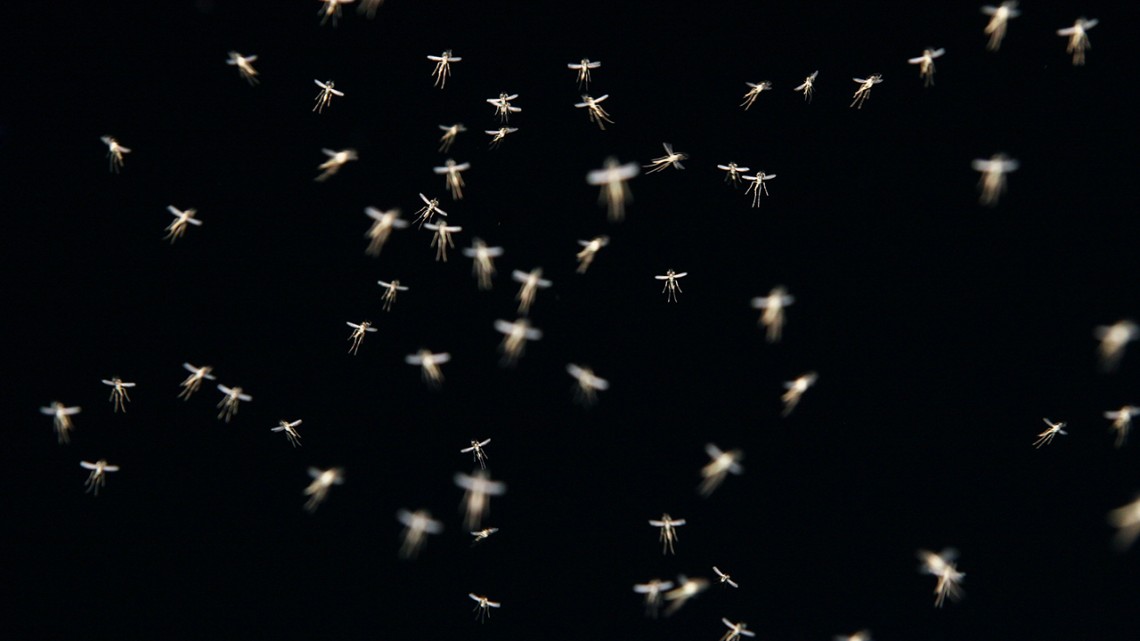
Collaboration yields insights into mosquito reproduction
By Krisy Gashler
As carriers for diseases like dengue and Zika, mosquitoes kill more than 1 million people each year and sicken hundreds of millions more. But a better understanding of mosquito reproduction can help humans combat outbreaks of these diseases, which are worsening as the climate warms.
Four Cornell researchers – two entomologists and two engineers – took a deeper look at this process. In a paper published in Nature Scientific Reports on Dec. 6, they documented nanoscale changes in the sperm of Aedes aegypti mosquitoes and watched how the females’ bodies responded during the insemination-to-fertilization period.
“We want to understand reproduction because if you can figure out ways to stop reproduction in the field, you could have mass mosquito birth control,” said Ethan Degner, Ph.D. ’19, co-lead author of the paper along with Jade Noble, Ph.D. ’18.
Degner completed his Ph.D. under Laura Harrington, professor of entomology. Noble’s Ph.D. was under Lena Kourkoutis, associate professor of applied and engineering physics. The four wrote the paper.
Current efforts at controlling mosquito populations take two general approaches: modifying mosquito habitat, by spraying pesticides or reducing areas of standing water that mosquitoes use for breeding; and making biological changes, like releasing sterile males into the environment or genetically modifying males to produce inviable offspring.
The Cornell researchers hope their fundamental research will lead to more effective methods of managing mosquito reproduction.
While scientists have known the pathway sperm take within female mosquitoes, Degner said, how sperm actually behave during the crucial period between insemination and fertilization was unknown.
To learn more, the entomologists needed better tools. Their standard light microscopes had a resolution limit of 400 nanometers, around the same wavelength as light, but they needed resolution at least 100 times smaller. By employing high-powered cryo-electron microscopy – the development of which won a trio of international scientists the 2017 Nobel Prize in chemistry, and which Kourkoutis uses regularly in her research – they could then see features up to 100,000 times smaller.
“With electron microscopy, you can theoretically see features on the order of picometers (trillionths of a meter),” Noble said. “This was exactly what we needed to see the change in features in the sperm. Some of the features we were looking at were only 8-9 nanometers.”
Using a powerful electron microscope, they discovered that the mosquitoes’ sperm shed their entire outer coat, called the glycocalyx, within 24 hours of inseminating the female. They also observed that the shedding process appeared to wake the sperm from a dormant state and trigger one of rapid motility. Intriguingly, as the sperm become more mobile, this somehow encouraged the female mosquito to become more fertile.
The second key component of this research came from the ability to cryo-freeze mosquito sperm and fix them in a near-native state. Traditional entomological research involves infusing insect specimens with a chemical fixative, dehydrating them, then adding a dye to help see different features.
However, at such a small scale, that process introduced the possibility that changes observed in sperm might be due to the preparation, rather than natural changes in the sperm. Through this unique partnership, the cryo-freezing process enabled the researchers to “be a little more certain that the features we saw in our images were due to the sperm changing and not due to the sample preparation,” Noble said.
“That’s another reason why this collaboration was so helpful,” she said, “because it’s opening the door to the idea that biologists can really benefit from these high-powered tools.”
Noble and Degner knew each other through several on-campus organizations, and while discussing their respective research, realized the benefits of collaborating. Harrington said she hopes this radical collaboration will be the first of many.
“The potential for this tool to increase our understanding of the biology of sperm and physiology of mosquito pathogen interactions is tremendous,” she said. “I hope we can employ this approach to explore these other areas in the future.”
Krisy Gashler is a freelance writer for the College of Agriculture and Life Sciences.
Media Contact
Get Cornell news delivered right to your inbox.
Subscribe
